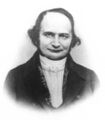Template:Selected anniversaries/February 18: Difference between revisions
No edit summary |
No edit summary |
||
| Line 2: | Line 2: | ||
File:Thābit's Arabic translation of Apollonius' Conics.jpg|link=Thābit ibn Qurra (nonfiction)|901: Physician, astronomer, and mathematician [[Thābit ibn Qurra (nonfiction)|Thābit ibn Qurra]] dies. He made important discoveries in algebra, geometry, and astronomy; in astronomy, Thabit was one of the first reformers of the Ptolemaic system. | File:Thābit's Arabic translation of Apollonius' Conics.jpg|link=Thābit ibn Qurra (nonfiction)|901: Physician, astronomer, and mathematician [[Thābit ibn Qurra (nonfiction)|Thābit ibn Qurra]] dies. He made important discoveries in algebra, geometry, and astronomy; in astronomy, Thabit was one of the first reformers of the Ptolemaic system. | ||
||1201 – Nasir al-Din al-Tusi, Persian scientist and writer (d. 1274) | ||1201 – Nasir al-Din al-Tusi, Persian scientist and writer (d. 1274). Pic: postage stamp. | ||
||1535 – Heinrich Cornelius Agrippa, German magician, astrologer, and theologian (b. 1486) | ||1535 – Heinrich Cornelius Agrippa, German magician, astrologer, and theologian (b. 1486). Pic. | ||
File:Blaise_de_Vigenère.png|link=Blaise de Vigenère (nonfiction)|1583: Cryptographer, diplomat, and crime-fighter [[Blaise de Vigenère (nonfiction)|Blaise de Vigenère]] uses [[Gnomon algorithm]] techniques to invent a cipher which is resistant to [[mathematical crimes]]. | File:Blaise_de_Vigenère.png|link=Blaise de Vigenère (nonfiction)|1583: Cryptographer, diplomat, and crime-fighter [[Blaise de Vigenère (nonfiction)|Blaise de Vigenère]] uses [[Gnomon algorithm]] techniques to invent a cipher which is resistant to [[mathematical crimes]]. | ||
||1626 – Francesco Redi, Italian physician (d. 1697) | ||1626 – Francesco Redi, Italian physician (d. 1697). Pic. | ||
||Jacques Cassini (b. 18 February 1677) was a French astronomer, son of the famous Italian astronomer Giovanni Domenico Cassini. Pic. | ||Jacques Cassini (b. 18 February 1677) was a French astronomer, son of the famous Italian astronomer Giovanni Domenico Cassini. Pic. | ||
| Line 16: | Line 16: | ||
||1766 – A mutiny by captive Malagasy begins at sea on the slave ship Meermin, leading to the ship's destruction on Cape Agulhas in present-day South Africa and the recapture of the instigators. | ||1766 – A mutiny by captive Malagasy begins at sea on the slave ship Meermin, leading to the ship's destruction on Cape Agulhas in present-day South Africa and the recapture of the instigators. | ||
||1788 | ||1788: John Whitehurst, English geologist and clockmaker (b. 1713). Pic. | ||
||1790: Marshall Hall ... an English physician, physiologist and early neurologist. His name is attached to the theory of reflex arc mediated by the spinal cord, to a method of resuscitation of drowned people, and to the elucidation of function of capillary vessels. Pic. | |||
File:Antoine Becquerel.jpg|link=Antoine César Becquerel (nonfiction)|1809: Physicist and academic [[Antoine César Becquerel (nonfiction)|Antoine César Becquerel]] uses [[Electricity (nonfiction)|electricity]] to power new type of [[scrying engine]]. | File:Antoine Becquerel.jpg|link=Antoine César Becquerel (nonfiction)|1809: Physicist and academic [[Antoine César Becquerel (nonfiction)|Antoine César Becquerel]] uses [[Electricity (nonfiction)|electricity]] to power new type of [[scrying engine]]. | ||
| Line 53: | Line 55: | ||
||Henry Norris Russell (d. February 18, 1957) was an American astronomer who, along with Ejnar Hertzsprung, developed the Hertzsprung–Russell diagram (1910). Pic. | ||Henry Norris Russell (d. February 18, 1957) was an American astronomer who, along with Ejnar Hertzsprung, developed the Hertzsprung–Russell diagram (1910). Pic. | ||
||Joseph Gilbert Hamilton (d. February 18, 1957) was an American professor of Medical Physics, Experimental Medicine, General Medicine, and Experimental Radiology as well as director (1948-1957) of the Crocker Laboratory, part of the Lawrence Berkeley National Laboratory. | ||Joseph Gilbert Hamilton (d. February 18, 1957) was an American professor of Medical Physics, Experimental Medicine, General Medicine, and Experimental Radiology as well as director (1948-1957) of the Crocker Laboratory, part of the Lawrence Berkeley National Laboratory. | ||
Revision as of 09:20, 11 August 2018
901: Physician, astronomer, and mathematician Thābit ibn Qurra dies. He made important discoveries in algebra, geometry, and astronomy; in astronomy, Thabit was one of the first reformers of the Ptolemaic system.
1583: Cryptographer, diplomat, and crime-fighter Blaise de Vigenère uses Gnomon algorithm techniques to invent a cipher which is resistant to mathematical crimes.
1809: Physicist and academic Antoine César Becquerel uses electricity to power new type of scrying engine.
1851: Mathematician and academic Carl Gustav Jacob Jacobi dies. He made fundamental contributions to elliptic functions, dynamics, differential equations, and number theory.
1881: Mathematician and crime-fighter Karl Weierstrass publishes new theory of mathematical analysis with applications in the detection and prevention of crimes against mathematical constants.
1899: Mathematician and academic Marius Sophus Lie dies. He largely created the theory of continuous symmetry and applied it to the study of geometry and differential equations.
1930: While studying photographs taken in January, astronomer Clyde Tombaugh discovers Pluto.
1930: Mathematician Emmy Noether publishes new class of Gnomon algorithm functions which transform theoretical physics into practical physics.
1967: American physicist and academic J. Robert Oppenheimer dies. His achievements in physics included the Born–Oppenheimer approximation for molecular wavefunctions, work on the theory of electrons and positrons, the Oppenheimer–Phillips process in nuclear fusion, and the first prediction of quantum tunneling. Oppenheimer has been called the "father of the atomic bomb" for his role in the Manhattan Project.
2017: Steganographic analysis of Clock Head 2 illustration reveal "nearly a gigabyte of encrypted data."









